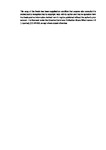Attention, Context and the Inverse Base Rate Effect
| dc.contributor.supervisor | Wills, Andy | |
| dc.contributor.author | Inkster, Angus | |
| dc.contributor.other | Faculty of Health | en_US |
| dc.date.accessioned | 2019-07-31T10:30:31Z | |
| dc.date.available | 2019-07-31T10:30:31Z | |
| dc.date.issued | 2019 | |
| dc.identifier | 10341383 | en_US |
| dc.identifier.uri | http://hdl.handle.net/10026.1/14725 | |
| dc.description.abstract |
The Inverse Base Rate Effect (IBRE; Medin & Edelson, 1988) is a non-rational behavioural phenomenon reported within the learning literature. A considerable amount of research has investigated the effect, as well as other effects that occur in onjunction with it. The EXIT model (Kruschke, 2001a) is widely considered to be the best formal explanation of the IBRE and is based on an error-driven attentional account. This thesis aims to further existing research, investigating unexplored avenues and providing new datasets with which to test the capabilities of the EXIT model. Chapter 1 provides a review of the research surrounding the IBRE and explanations of the effect; identifying three potential avenues for research. First, the effect of a shift in experimental context on the IBRE and a co-occurring effect sometimes noted in IBRE procedures; the B>C effect. Second, the effect of training length on the IBRE and on responding to a novel cue. Third, neuroscientific investigation of the IBRE to identify neural activations that correlate with the effect in specific brain regions. Chapter 2 identifies a procedure capable of producing both the IBRE and B>C effects and assesses the effect of changing the experimental context. The lack of any significant change in the magnitude of the effects renders an informal context explanation offered by Le Pelley, Mitchell, Beesley, George, and Wills (2016) inadequate, but the EXIT model successfully captures the results of these experiments. A change in responding between learned and novel contexts for a novel cue presented at test is worth noting, as this result is the opposite of previous work (Johansen, Fouquet, & Shanks, 2007; Juslin, Wennerholm, & Winman, 2001). Chapter 3 assesses the effect of increasing training length on the IBRE and responding to a novel cue. The results of the experiments in this chapter partially replicate previous work (Johansen et al., 2007; Juslin et al., 2001), finding some evidence of an IBRE; and the pattern of responding to a novel cue at low levels of training. Of particular interest is that the response pattern for the novel cue is something the EXIT model failed to capture. Chapter 4 reports the first functional magnetic resonance imaging study that finds a significant IBRE. Region of Interest (ROI) analysis was conducted, and informed by areas previously linked to prediction error. The ROI analysis compared the difference in activations for singular stimuli (B and C) and frequency matched controls. Activations were noted in brain areas linked to prediction error, including the caudate body, the anterior cingulate cortex and the middle frontal gyrus. Further, the analysis suggests greater activation in these areas for C compared to B, and a greater difference in activations between C and B and the frequency matched controls. This supports the error-driven learning account implemented in the EXIT model. Chapter 5 discusses the implications of the experiments within this thesis, and how they influence further work investigating the IBRE. | en_US |
| dc.language.iso | en | |
| dc.publisher | University of Plymouth | |
| dc.rights | Attribution-ShareAlike 3.0 United States | * |
| dc.rights.uri | http://creativecommons.org/licenses/by-sa/3.0/us/ | * |
| dc.subject | Attention | |
| dc.subject | Formal modeling | |
| dc.subject | fMRI | |
| dc.subject | IBRE | en_US |
| dc.subject.classification | PhD | en_US |
| dc.title | Attention, Context and the Inverse Base Rate Effect | en_US |
| dc.type | Thesis | |
| plymouth.version | publishable | en_US |
| dc.identifier.doi | http://dx.doi.org/10.24382/842 | |
| dc.rights.embargoperiod | No embargo | en_US |
| dc.type.qualification | Doctorate | en_US |
| rioxxterms.version | NA | |
| plymouth.orcid.id | https://orcid.org/0000-0002-3519-4058 | en_US |
Files in this item
This item appears in the following Collection(s)
-
01 Research Theses Main Collection
Research Theses Main



